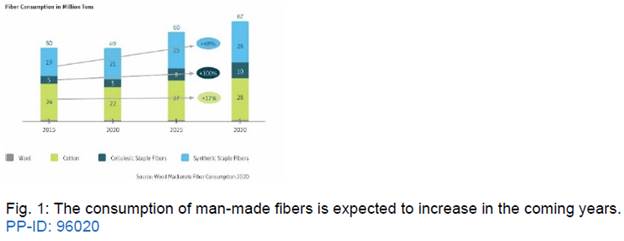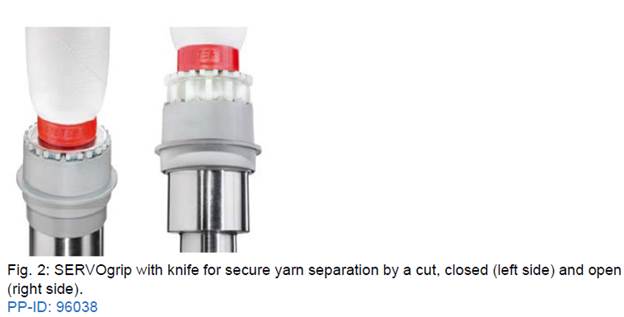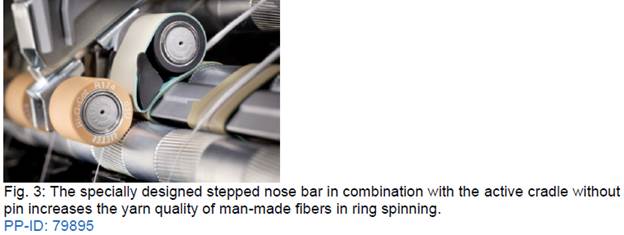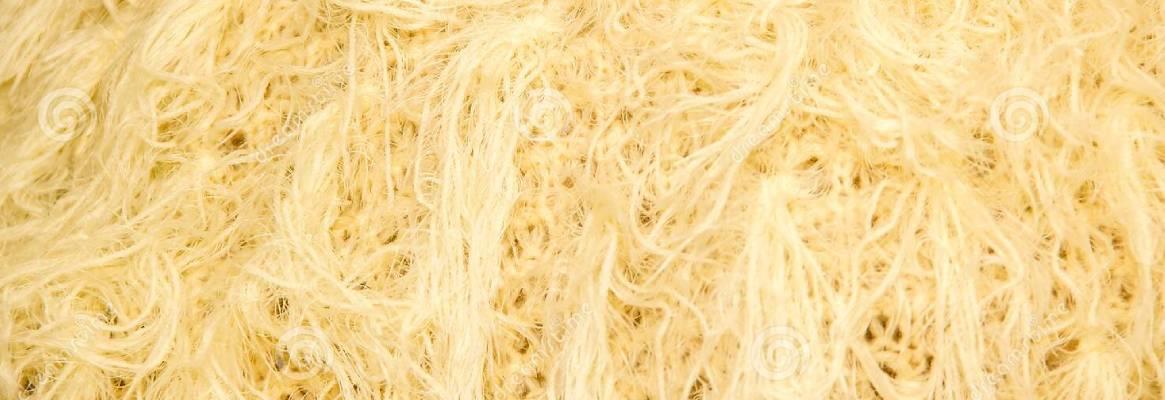Fiber consumption is on the rise, and man-made fibers (MMF) play an important role in this. Blends containing various fiber materials are particularly popular and are found in an increasing number of applications. The ring spinning machine G 38 offers unique solutions for processing MMF and blends.
As population growth and prosperity increase, so does the consumption of fibers across the globe. While this holds true for all staple fibers, the use of man-made fibers such as cellulosic staple fibers and synthetic staple fibers is growing particularly quickly. The consumption of cellulosic staple fibers is expected to double to 10 million tons by 2030 while the consumption of synthetic staple fibers is expected to grow by 48% to 28 million tons compared to 2015 (Fig. 1). Rieter addresses these market needs and continuously develops innovative technology components and solutions for MMF and blends for all end spinning processes.
MMF package for ring spinning
Synthetic fibers – usually polyester – and their blends with cotton are commonly processed on ring spinning machines. Different blends with cellulosic fibers are another popular application. In general, ring spinning is very flexible compared to other spinning processes and reacts less sensitively to fiber finish deposits which is a common challenge when processing MMF. Nevertheless, there are some technology elements on the ring spinning machine that have been specially developed for the characteristics of MMF and special settings that should be considered. One of these technology elements is the bottom roller with a diameter of 30 mm. It helps to reduce the build-up of fiber lapping for fine fibers like MMF.
Thanks to an additional drive unit for the middle bottom roller, positioned in the middle of the machine, Rieter can offer long ring spinning machines also for MMF: The G 37 machine with semi-electronic drafting system drive can be equipped with up to 1 632 spindles and the G 38 machine with a fully electronic drafting system drive with up to 1 824 spindles.
High tenacity requires special solutions
Due to their high tenacity, synthetic fibers cause higher part wear during processing. This can be mitigated by installing separators with reinforced front edges. These edges help to protect the separators from the fiber ends in the event of an ends down and increase the life cycle of the parts significantly. The high tenacity of synthetic fibers also poses challenges in terms of reliable detachment during the cop change procedure. If the detachment is unsuccessful, this can result in dragged yarn and a series of ends down, which affects yarn quality and efficiency. For this reason, a special SERVOgrip with a knife has been developed that reliably cuts off the yarn during the doffing process and prevents yarn breaks during start-up (Fig. 2).
Correct settings improve yarn quality
Furthermore, the correct setting of the drafting system is important for yarn quality. The width of the drafting zone as well as the appropriate cradle nose bar and top apron should be defined according to the fiber length and the draft resistance of the raw material. For man-made fibers up to a cut length of 38 mm, the use of the stepped nose bar in combination with the specific active cradle without pin (Fig. 3) improves yarn quality. With an active cradle, the top aprons are tensioned by a spring-loaded leading edge. Variations in apron tension are automatically compensated. It also permits lower cradle spacing for better guidance of the fibers, resulting in better yarn quality.
Tailor-made rings and travelers
Synthetic fibers do not self-lubricate the way cotton does and have a lower melting point. These properties are addressed by the oblique ORBIT ring and corresponding traveler in various surface finishes, which were specifically developed for spinning synthetic fibers. They guarantee smooth guiding properties and have a good heat diffusion to prevent melting spots. The ORBIT ring/traveler system handles the fibers very gently thanks to the large contact area between ring and traveler, as well as the reduced targeted surface pressure.
Compacting technology with wider application range
While it is less common, MMF can also be processed on compact-spinning machines. An important feature is the new sieve drum which is available as a standard on the compact-spinning machine K 48 and as an option on the K 47. A new coating has improved the durability of the sieve drum 20-fold compared to the previous series. The application range covers 100% cotton, viscose, polyester, and their blends.
MMF and sustainability
A lot of research and development is currently underway to make MMF more sustainable, with recycling offering the greatest opportunity. The key to this is polyester with its large market share. In 2019 the share of recycled polyester reached 14%, mostly using plastic bottles as feedstock. Numerous innovative initiatives have the potential to accelerate the transition to a circular economy.
An overview of all solutions for MMF in the Rieter system, from the blowroom to all four end spinning processes, can be found on www.rieter.com.



About Rieter
Rieter is the world’s leading supplier of systemsfor short-staple fiber spinning. Based in Winterthur (Switzerland), the companydevelops and manufactures machinery, systems and components used to convertnatural and man-made fibers and their blends into yarns. Rieter is the onlysupplier worldwide to cover both spinning preparation processes and all fourend-spinning processes currently established on the market. Furthermore, Rieteris a leader in the field of precision winding machines. With 15 manufacturinglocations in 10 countries, the company employs a global workforce of some 4400, about 20% of whom are based in Switzerland. Rieter is listed on the SIXSwiss Exchange under ticker symbol RIEN.








Comments